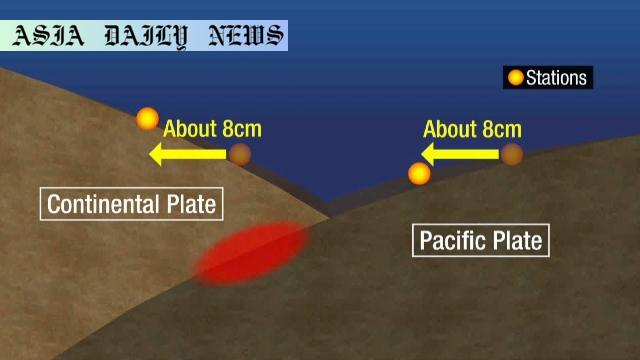Mega-quake: Research team warns of possible magnitude 9-level mega-quake off Hokkaido due to unreleased stress energy.
- Mega-quake: Researchers identify potential seismic risks near Hokkaido.
- Plate movement indicates accumulated stress since 17th century.
- Intriguingly high probability of magnitude 8.8+ quake in 30 years.

Unreleased Stress Energy Could Spark a Mega-Quake Off Hokkaido
Recent scientific findings have rung alarms about a possible catastrophic earthquake off the coast of Hokkaido, Japan. A dedicated research team, comprising experts from Tohoku and Hokkaido universities and the Japan Agency for Marine-Earth Science and Technology, has spent half a decade studying seismic activity at the Chishima Trench. Their alarming results have unveiled that an immense amount of stress energy has been accumulating, enough to potentially unleash a magnitude 9-level “mega-quake.” This discovery isn’t devoid of historical precedence, as a massive quake is believed to have occurred in this very region during the 17th century.
The seismic risks have grown so pronounced that Japan’s government earthquake panel has estimated the likelihood of a quake with a magnitude of at least 8.8 occurring within the next 30 years at anywhere between 7 and 40 percent. The lingering threat of such a mega-disaster has urged researchers to highlight the need for heightened awareness and preparedness among the local population.
How Plate Movements Signal a Looming Threat
The foundational evidence for this warning lies in precise GPS observations conducted since 2019. Observation stations set up on the seabed around the oceanic plate have exhibited consistent movement of approximately 8 centimeters per year toward the continental plate. Interestingly, data shows that even a station situated on the continental plate itself mirrored this movement. This in tandem strongly suggests that portions of these plates remain firmly locked together, allowing strain energy to build over centuries without release.
Based on historical analysis and seismic modeling, researchers postulate that such an accumulation could replicate the energy released during historical mega-quakes. If these plates have remained locked in this fashion since the 17th-century quake, the released energy could approach or even surpass the equivalent of a magnitude 9-level earthquake.
Studying the Past to Prevent Future Disasters
Historically, tsunamis and earthquakes of this caliber bring devastation on a scale that is difficult to comprehend. Lessons from the 2011 Great East Japan Earthquake, which claimed nearly 20,000 lives and caused unprecedented infrastructure collapses, underscore the gravity of proactive disaster preparedness. However, Assistant Professor Tomita Fumiaki of Tohoku University warns that public memory seems to be fading about such catastrophic events, reducing vigilance at a time when heightened awareness is critical.
The research team, acknowledging these dangers, has outlined plans to expand their focus. They aim to study additional regions off the coast of Hokkaido to analyze strain buildup and seismic threats. Such distributed understanding could not only refine preparedness strategies for Japan but provide global insights into tectonic activity.
Outstanding Questions and the Need for Preparedness
While the science points toward an imminent mega-quake scenario, uncertainty around exact timing remains a major challenge. Earthquake predictions remain a complex and exacting field; despite technological advancements, pinpointing the exact month or year continues to elude modern seismologists. However, tracking probabilities and logistical preparedness has already proven to save lives.
By understanding and acting on probabilities like the 7 to 40 percent estimate provided for the next 30 years, communities can significantly mitigate both human and economic costs when disaster does strike. Experts urge governmental agencies and individuals alike to adopt constant seismic preparedness measures such as evacuation plans, emergency supplies, and robust building infrastructures.
Looking Ahead: Grasping the Urgency
Though regions like Hokkaido are no strangers to tectonic activity, the potential magnitude of the forecasted mega-quake underscores an unparalleled urgency for preparedness. As monitoring data becomes more precise, studies like these play a pivotal role in creating a safer world for earthquake-prone communities in Japan and globally.
To address these lingering challenges, greater public engagement, regular disaster drills, and government initiatives will play an irreplaceable role. As history has painfully illustrated, preparedness is the only shield humanity has against the forces of nature.



Commentary
The Importance of Vigilance Against Seismic Threats
The looming possibility of a mega-quake off the coast of Hokkaido is a chilling reminder of the Earth’s immense, yet unpredictable, power. News of unreleased stress energy accumulating beneath the Chishima Trench emphasizes the importance of constant vigilance in earthquake-prone regions. These findings reveal nature’s profound ability to store energy over centuries, only to unleash it in catastrophic bursts.
Memories of Disaster Must Not Fade
Japan’s experience with devastating seismic events, most notably the harrowing 2011 Great East Japan Earthquake, highlights a poignant necessity: to remain prepared at all times. However, Assistant Professor Tomita’s observation that memories are fading of the 2011 disaster raises a troubling concern. The fading collective memory often leads to a lapse in disaster preparedness, even when science strongly advocates for remaining alert.
Science as a Guiding Light
The research conducted by Tohoku and Hokkaido universities demonstrates how far science has come in unraveling Earth’s mysteries. Assessment methods such as GPS seabed monitoring allow researchers to identify hidden threats like accumulating stress in tectonic plates. This advanced understanding should bolster public confidence in relying on science to anticipate dangers and inform proactive measures.
The Balance Between Readiness and Uncertainty
Still, no scientific model can pinpoint precisely when or where a quake will occur, and that brings its own challenges. What must remain clear is that any level of seismic prediction, no matter how broad its timelines, is an invitation to prepare better and stronger. Governments must address this challenge with rigorous policy implementation and public outreach.
In essence, this warning about the potential for a mega-quake is both a dire alert and a vital opportunity to save lives and protect communities. While scientific capability continues to evolve, so too must society’s commitment to readiness and response.